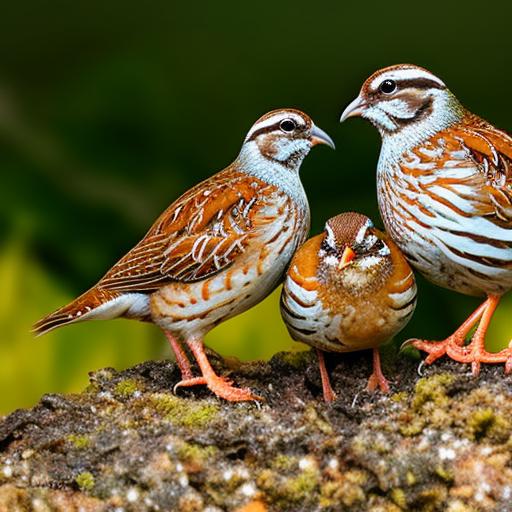Quails are small, ground-dwelling birds that are known for their social nature and strong flocking instincts. They are highly social birds and prefer to live in groups, known as coveys, for safety and companionship. Within a covey, quails establish a social hierarchy through displays of dominance and submission. This hierarchy helps to maintain order within the group and reduces the likelihood of conflict. Quails communicate with each other through a variety of vocalizations and body language, which helps them to coordinate their movements and activities within the group. Understanding quail behavior and social structure is essential for creating a harmonious and healthy living environment for these birds.
Quails are also known for their strong pair-bonding behavior, with males and females forming monogamous pairs during the breeding season. These pairs often remain together throughout the year, providing each other with companionship and support. In addition to their pair-bonding behavior, quails also engage in cooperative breeding, with multiple females laying eggs in a communal nest and sharing the responsibility of incubating and raising the chicks. This cooperative behavior helps to ensure the survival of the young birds and strengthens the bonds within the covey. Overall, understanding the social structure and behavior of quails is crucial for creating a suitable living environment that promotes their natural instincts and well-being.
Key Takeaways
- Quail are social birds that form strong bonds and hierarchies within their groups.
- Factors such as space, resources, and species compatibility should be considered when determining quail group size.
- Different quail species have varying ideal group sizes, with some being more social than others.
- Proper management of quail enclosures and providing adequate space is crucial for the well-being of quail groups.
- Aggression and hierarchy within quail groups should be monitored and addressed to maintain a harmonious environment.
Factors to Consider When Determining Quail Group Size
When determining the group size for quails, there are several important factors to consider. The size of the enclosure, the species of quail, and the purpose of keeping the birds all play a role in determining the ideal group size. The size of the enclosure is one of the most critical factors to consider when determining quail group size. A larger enclosure can accommodate a larger group of quails, allowing them to move around freely and engage in natural behaviors such as foraging and dust bathing. On the other hand, a smaller enclosure may not be suitable for a large group of quails, as it can lead to overcrowding and increased competition for resources.
The species of quail also plays a significant role in determining group size. Some species, such as the Japanese quail, are more social and can tolerate larger group sizes, while others, such as the California quail, prefer smaller groups and may become stressed in larger flocks. Additionally, the purpose of keeping quails should be taken into consideration when determining group size. For example, if the quails are being kept for breeding purposes, smaller groups may be more suitable to allow for pair bonding and nesting behaviors. Overall, considering the size of the enclosure, the species of quail, and the purpose of keeping the birds are all important factors to consider when determining the ideal group size for quails.
Ideal Group Sizes for Different Quail Species
The ideal group size for different quail species can vary based on their natural behavior and social structure. Japanese quails, also known as Coturnix quails, are highly social birds that can tolerate larger group sizes compared to other species. In a spacious enclosure with plenty of hiding spots and resources, a group of 10-15 Japanese quails can coexist harmoniously. They are known for their strong flocking instincts and can thrive in larger groups as long as there is enough space and resources available.
On the other hand, California quails are known for their preference for smaller group sizes. These birds are more territorial and may become stressed in larger flocks. For California quails, a group size of 4-6 individuals is more suitable to prevent aggression and maintain a peaceful living environment. Gambel’s quails, another popular species kept in captivity, also prefer smaller group sizes similar to California quails. Understanding the natural behavior and social structure of different quail species is essential for determining the ideal group size that promotes their well-being and reduces the likelihood of conflict within the group.
Managing Quail Enclosures and Space Requirements
Managing quail enclosures and meeting their space requirements is crucial for promoting their well-being and natural behaviors. Quails require ample space to move around, forage for food, dust bathe, and establish territories within the group. When designing a quail enclosure, it’s important to provide enough space for each bird to engage in these natural behaviors without feeling crowded or stressed. A general rule of thumb is to provide at least 1-2 square feet of space per quail to ensure they have enough room to move around comfortably.
In addition to space requirements, providing hiding spots, such as shrubs or artificial shelters, can help reduce stress and aggression within the group. Hiding spots allow quails to escape from potential conflicts or seek privacy when needed. It’s also important to consider the layout of the enclosure to prevent overcrowding around food and water sources. By providing multiple feeding and watering stations throughout the enclosure, quails can access these resources without having to compete with other group members. Overall, managing quail enclosures and meeting their space requirements is essential for creating a healthy and harmonious living environment for these birds.
Addressing Aggression and Hierarchy within Quail Groups
Aggression and hierarchy within quail groups are natural behaviors that play a role in establishing order and maintaining social structure. However, excessive aggression or bullying within the group can lead to stress, injuries, and reduced well-being among the birds. It’s important to monitor the behavior of quails within the group and address any signs of aggression or dominance that may disrupt the harmony within the flock.
One way to address aggression within quail groups is by providing ample space and resources to reduce competition. Overcrowding or limited access to food and water can lead to increased aggression as birds compete for these essential resources. By ensuring that there are enough feeding and watering stations available throughout the enclosure, quails can access these resources without having to engage in aggressive behaviors.
Another strategy for addressing aggression within quail groups is by providing hiding spots and visual barriers within the enclosure. Hiding spots allow submissive birds to escape from potential conflicts or seek privacy when needed. Visual barriers such as plants or structures can also help break line of sight between aggressive individuals, reducing confrontations within the group.
Overall, addressing aggression and hierarchy within quail groups requires careful observation of their behavior and proactive measures to create a harmonious living environment that promotes their well-being.
Monitoring Quail Health and Well-being in Group Settings

Monitoring quail health and well-being in group settings is essential for identifying any potential issues or illnesses that may arise within the flock. Regular observation of their behavior, appetite, and physical condition can help detect early signs of stress or illness. It’s important to pay attention to any changes in behavior or activity levels within the group, as these can be indicators of underlying health issues.
In addition to behavioral observation, regular health checks should be conducted to assess the overall condition of the birds. This includes checking for signs of parasites, injuries, or abnormalities in their feathers or skin. Providing a balanced diet with access to clean water is also crucial for maintaining their health in a group setting.
Creating a suitable living environment with proper space, hiding spots, and access to resources can also contribute to their overall well-being within the group. By addressing any potential stressors or conflicts within the flock, it’s possible to create a harmonious living environment that promotes their health and natural behaviors.
Tips for Introducing New Quail to an Existing Group
Introducing new quail to an existing group requires careful planning and consideration to minimize stress and potential conflicts among the birds. One important tip is to quarantine new birds before introducing them to the existing group. This allows time to observe their health and behavior while preventing the spread of any potential illnesses to the established flock.
When introducing new quail to an existing group, it’s important to do so gradually to allow them to acclimate to each other’s presence. Placing new birds in a separate enclosure within sight of the existing group can help them become familiar with each other without direct contact. After a period of observation and gradual introduction, they can be released into the main enclosure under close supervision.
Providing multiple feeding and watering stations can also help reduce competition among new and existing group members during the introduction process. This ensures that all birds have access to essential resources without having to compete with each other.
Overall, introducing new quail to an existing group requires patience, observation, and careful management to minimize stress and promote a smooth transition for all birds involved.
If you’re wondering how many quail you can keep together, you might also be interested in learning about the ideal coop size for chickens. Poultry Wizard’s article on “how big does a coop need to be for a chicken” provides valuable insights into creating a comfortable living space for your feathered friends. Check it out here.
FAQs
How many quail can I keep together in a cage?
Quail are social birds and should be kept in groups of at least 3-4 to prevent loneliness and stress. The size of the cage will also determine the number of quail you can keep together.
What is the recommended space requirement for keeping quail together?
Each quail should have a minimum of 1 square foot of space in the cage. This means that a cage that is 2 feet by 2 feet can comfortably house 4 quail.
Can different species of quail be kept together?
It is not recommended to keep different species of quail together as they may have different social behaviors and could potentially harm each other.
What are the social behaviors of quail when kept together?
Quail are social birds and will establish a pecking order within their group. It is normal for them to peck at each other occasionally, but if there is excessive aggression, it may be necessary to separate the birds.
What are the factors to consider when keeping quail together?
Factors to consider when keeping quail together include the size of the cage, the sex ratio of the birds, and the compatibility of the birds within the group. It is important to monitor the birds for any signs of stress or aggression.
Meet Walter, the feathered-friend fanatic of Florida! Nestled in the sunshine state, Walter struts through life with his feathered companions, clucking his way to happiness. With a coop that’s fancier than a five-star hotel, he’s the Don Juan of the chicken world. When he’s not teaching his hens to do the cha-cha, you’ll find him in a heated debate with his prized rooster, Sir Clucks-a-Lot. Walter’s poultry passion is no yolk; he’s the sunny-side-up guy you never knew you needed in your flock of friends!







